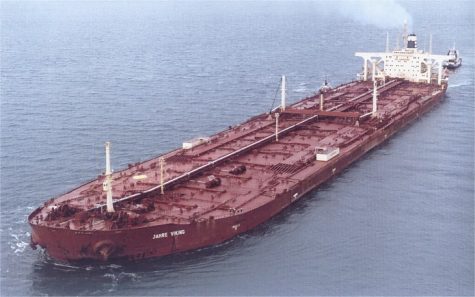Did You Know?
With the scandalously large impact of current events, I feel it is fitting to go over twenty facts on relatively large things, such as…
- The largest unicellular organism in the algae “Valonia Ventricosa” which can measure up to a five centimeter diameter, though this normally ranges from one to four centimeters. These cells are so massive that merely one nucleus is not enough for the entire cell. So instead the layer near the surface is divided into “chambers” each of which have their own nucleus and organelles so that way if one chamber is broken the cell does not die. Most of the rest of the cell is a massive vacuole. It thrives in the warmer parts of oceans across the world. In this hemisphere it lives north from the coast of Florida down to the coast of Brazil. In the eastern hemisphere it lives in many parts of the Indian and Pacific Oceans.
- The largest weapon ever used was the Schwerer Gustav, an artillery piece which could fire 800 mm (31.5 inch) calibre shells, which weighed over five tonnes each, over a distance of 47 kilometers. This machine weighed 1,350 tonnes and was over 155 feet long. It was meant to be used to destroy the fortifications of the Maginot line in the Nazi blitzkrieg of France in 1940, however, by the time it was ready to fire the invasion was already over.

- The world’s heaviest insect is the aptly named Goliath Beetle, which can weigh up to 100 grams. However, this state is only maintained for a short amount of time, when it undergoes metamorphosis.
- The largest ship ever built was the 1,500 feet long oil tanker “Seawise Giant.” This ship, which could carry over half a million tons, was originally built in Japan in ‘74 but was elongated in Hong Kong, so it could carry an additional 100,000 tons of cargo. In ‘88 it was sunk off to coast of Iran by the Iraqi air force during the Iran-Iraq war. However, it was recovered and served until 2010 when it was scrapped in India.
- The largest planet known to man is HD 100546 b, which orbits a ten million year old star that is 320 light years away from earth. This planet is so large it may not be a planet at all, but a brown dwarf star, a very small star. The star it orbits is also rather small for a star, although it has an atypically short lifespan for a star of its size. It is also the closest star to us of its kind.
- The largest star known to man is the red supergiant of UY scuti of the constellation scutum. Going by the largest estimations, its radius is almost two billion kilometers large. Its circumference so so vast that it would take a particle of light 2.2 hours to cross it. It takes a particle of light eight seconds to get from the sun to the Earth. This would give it a volume five billion times larger than the sun. If it replaced the sun of as the star of the solar system, it engulf all the planets in the solar system up to Saturn. It is bright enough that even though it is 9,500 light years away from earth it can still be seen under a clear sky with no light pollution.
- The most populous city in the world is Tokyo, the capital of Japan is home to over 13 million people. It is so large that it functions as both a prefecture (like a state) and a city. It is split into 23 special wards which are in of themselves governed like cities. For most of history, this city was founded in the twelfth century as Edo, a meagre fishing village. This changed when Tokugawa Ieyasu, the future shogun of Japan made it his base of operations in the warring states period which lasted 1603. When Ieyasu became shogun he changed the capital of Japan from Kyoto to Edo, which he then renamed Tokyo (which means “eastern capital”). This new age of peace let the city thrive, and when Japan modernized in the late nineteenth century it exploded accordingly with the introduction of railways and electricity.
- The heaviest person to ever live was Jon Brower Minnoch, who at his peak weight weighed approximately 1,400 pounds. He was plagued throughout his 41 years of life with a condition which caused an extreme amount of water to build up inside him. After he was hospitalized at his highest weight in 1978 he tried to lose weight, going down to 500 pounds. However he was readmitted to the hospital in 1981 after gaining nearly 500 pounds. He latter died in 1981 weighing nearly 800 pounds.
- The longest word in any English dictionary is the fourty five lettered Pneumonoultramicroscopicsilicovolcanoconiosis, is according to the Oxford English Dictionary “an artificial long word said to mean a lung disease caused by inhaling very fine ash and sand dust.” This word was invented by Everett M. Smith, the president of the national puzzlers league in their annual meeting of 1935.
- The longest word period is a sanskrit word consisting of 431 letters, which appeared in a poem by Tirumalamba, who wrote poems in the 16th century in service of her kingdom, Vijayanagar (Southern India.) Sanskrit is a language that allows compound words to be formed by combining nouns and verbs to create compound words, in theory allowing for the creation for an infinitely long word.
- The longest bloodiest battle in history is the Battle Of Stalingrad, fought in a city on the banks of the River Volga, near the edge of Europe from the August of 1942 to the February of ‘43. By that point in World War 2, the Germans had conquered most of Europe with extreme efficiency, until they reached the Soviet Union. On the spring of 42’ the Germans launched “Operation Barbarossa” which was a colossal invasion meant to conquer the Union in a matter of months. Although in the beginning they were extraordinarily successful, the months of fighting had short handed the Germans on an especially important resource – oil. The German army which heavily relied on motorized infantry, artillery and tanks, was tied to its supply to oil which was due to Britain’s blockade on Germany starting to run out. They realized that the only way they were going to stay in the war was to take Baku (a city in what is now Azerbaijan) which was an industrial center with a lucrative amount of oil. All that stood in their way by August was Stalingrad. Both sides recognized the importance of this battle and sent all they had available to that city. Even though it was soon reduced to rubble, they fought tooth and nail and by the time winter came the Germans, over extended in the heart of Russia, were stuck in the infamous Russian winter. Many of their machines simply refused work in the harsh temperatures. By February, the freezing, surrounded Germans defending what had become a series of potholes surrendered to the Red Army. After that, the Germans never won a single decisive battle in World War 2 ever again.
- The longest movie ever made was Logistics, released at the end of 2012. It is 35 days and 17 hours long. It is a movie which means to find out the process of creation of modern gadgets. So they tracked down a pedometer which was made starting in Insjon, Sweden to Shenzhen, China. This was filmed in real time. It was screened for the only time from December 1st 2012 to January 6th 2013, it was also shown at Shenzhen and can be streamed online.
- The longest youtube video which exist as of writing this article is titled “THE LONGEST VIDEO IN THE WORLD – 596.5 HOURS” which is over 24 days long. Supposedly, it is a background of fading colours, but I cannot confirm this since if you try to view it, it will not work. It was uploaded on December 14th 2011 by the youtuber “MoldytoasterMedia” who currently has slightly over 36,000 subscribers. It has over 2,800,000 views, however the comments and rating systems have been disabled. His last video was uploaded on August 2nd 2012.
- The largest molecule in the human body is a protein called Titin. Although it does have a longer, scientific name, however it has 189,819 letters in it. It could easily be the longest word to ever exist if its name did not count as a molecular formula rather than a word. It has upwards of 33,000 amino acids making it up, which also makes it the largest protein known to man (measuring at 1 micrometer in length.) This protein helps makes the muscles of the heart and skeleton elastic. It is one of the most common proteins in the average adult human body, each person having about half a kilogram of it in them.
- The largest gathering of people in history was at the place where the river Ganges and Yamuna at Allahabad, India, for the Hindu holiday of Maha Kumbh Mela. over 30 million people gathered there on February 10th 2013. This is a holiday of pilgrimage which is at four places, Allahabad is one of them. At these places patrons cleanse themselves of their sins by bathing in the water. According to mythology, this originated from a battle of the Devas (benevolent gods) and the Asuras (malevolent gods) for amrita, the drink of immortality. When this drink was produced, a carrier of the Devas tried to carry it to safety, but was assaulted so he split it at four places. These four places are where the Kumbh Melas are observed. Those 30 million people came during one day, this event lasted for two months which attracted 120 million pilgrims to it.
- The Sunway TaihuLight is the fastest supercomputer in the world, which can do 93 quadrillion (10^15) actions per second. This Chinese supercomputer is also the third most energy-effect of its kind, using about one watt for every 6 million actions. It uses 40,960 processors, and each processing chip has 256 processing cores. This makes for a total of over 10 million processing core across the entire system. For comparison, the computers in the library have a single chip with two cores.
- The largest bone in the human body is the Femur, or the thigh bone. It also just happens to be the hardest bone in the body and the only bone in the thigh. In Fact it makes up just over half of the height of the average person, which makes it handy for determining the height of an incomplete skeleton. In animals with four legs, it only appears in the hind legs.
- The person who has the record for longest amount of time spent without sleeping was Randy Gardner. He, in 1964, went without sleep for 264.4 hours, or 11 days and 24 minutes. The high school student from San Diego sought to prove that “bad things didn’t happen if you went without sleep.” Although there were very little ill side effects (in fact he was able to beat another person at pinball at the tenth day) he was made to be extremely moody and unable to concentrate. When he broke the record, he went to sleep for fourteen hours and woke up at 8:40 at night, and stayed up to 7:30 the next day.
- The person who spent the longest amount of time asleep was the Pole Jan Grzebski. After he was hit by a train in 1988 he went into a coma for nineteen years, after he woke up in 2007. When he went to sleep, the Soviet Union still had control over his native Poland. When he woke up, the Soviet Union had not existed for seventeen years, and the US had been waging a war on terror for six of those years.
- The largest thing that exist besides the universe itself is the Hercules-Corona Borealis Great Wall. Great Walls, in a cosmological sense, are gatherings of superclusters. Superclusters are in return a gathering galactic clusters which can have thousands of galaxies. Galaxies in return can have billions of stars. The Hercules-Corona Borealis Great Wall is over ten billion light years long, which is about twice as much as the second longest great wall discovered up to this point. In fact it is so large that it is 1/9th of the diameter of the entire observable universe. 10 billion light years is equal to about 9*10^24 meters. If you would try to imagine every digit of that number, a particle of light would have already traversed the length of this great wall.


